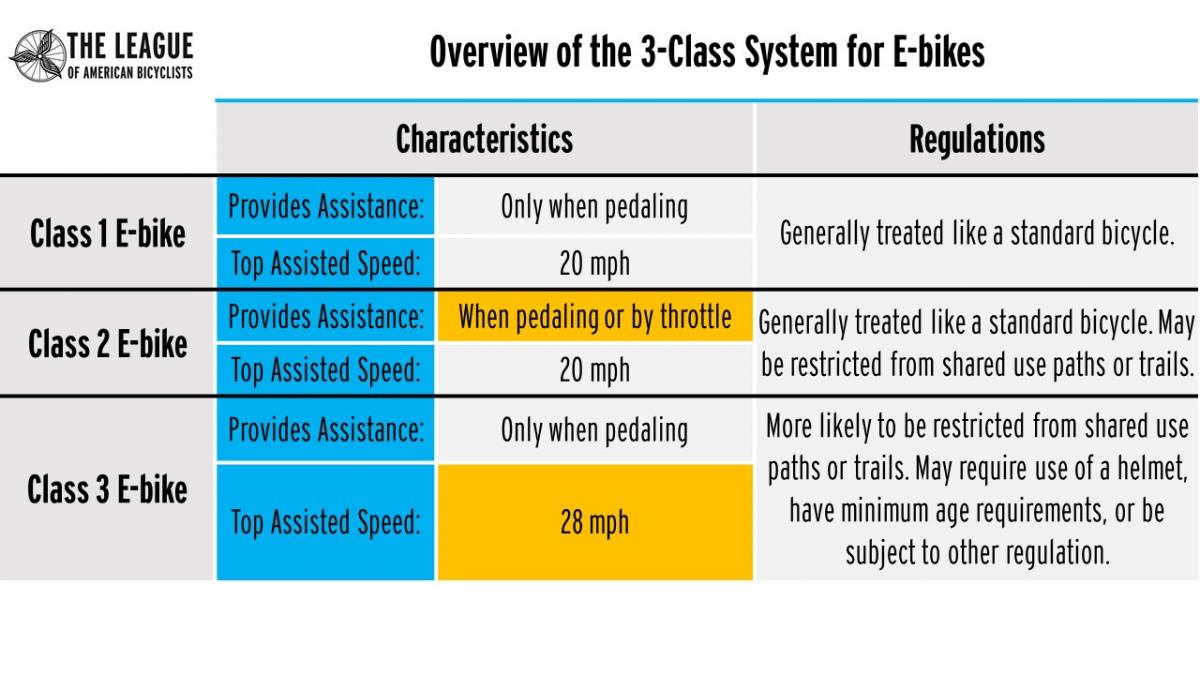E-Bikes
The League of American Bicyclists celebrates biking in all of the diverse forms it takes – whether road biking, commuting, recumbent biking, or e-biking. Life is better for everyone when more people are seeing the world from the seat of a bike (or trike!).
Electrically-assisted bicycles, also known as e-bikes, have become much more common in recent years. Advancements in battery technology and motors have made e-bikes lighter, cheaper, and more capable. Many people are finding e-bikes address their needs for everyday transportation, hauling cargo, and fun. At the League, we are glad to have more people biking more often.
We hope that this page helps people understand how e-bikes are regulated and what might be coming in the future for e-bikes.
Read our policy statement on e-bikes here.
Federal Law And E-Bikes
E-bikes are regulated by the Consumer Product Safety Commission (CPSC) as bicycles under a 2002 law. The CPSC is a federal agency that regulates the sale and manufacture of products – not how they are used.
According to federal law and CPSC regulations a ‘‘low-speed electric bicycle’’ is: A two-or-three-wheeled vehicle, with fully operable pedals, and an electric motor of less than 750 watts (1 h.p.), whose maximum speed on a paved level surface, when powered solely by such a motor while ridden by an operator who weighs 170 pounds, is less than 20 mph.
E-bikes that have assisted speeds higher than 20 mph are only lawfully e-bikes for the purpose of federal regulations if they require pedaling for assist at those higher speeds. Our 2015 report on e-bikes looked at bicyclist perceptions of e-bikes with different speeds and other characteristics.
Federal law generally does not say anything about the use of e-bikes, with one exception. Federal law provides that e-bikes can be used on federally funded non-motorized trails where state and local regulations permit.[23 USC 217(h)(4)] Oddly, this exception also puts one additional regulation on e-bikes used on those trails – e-bikes used on federally funded non-motorized trails must weigh under 100 pounds.[23 USC 217(j)(2)] In 2020, the Bureau of Land Management adopted regulations that will allow land managers to allow e-bikes on many non-motorized trails on public land.

The 3-class system is broadly similar to how e-bikes have been regulated in Europe for about a decade. There are three major differences that may or may not influence future e-bike policies in the United States:
The European equivalent of Class 1 e-bikes has a lower top assisted speed (15.5 mph vs 20 mph)
The European equivalent of Class 3 e-bikes is subject to more regulations (insurance is a current subject of debate)
Many European countries have incentive programs for the purchase of e-bikes to promote physical activity, safer transportation modes, and lower emissions.
E-bikes And Micromobility
While regulations for e-bikes are still evolving, they are nevertheless more developed than regulations for other micromobility devices such as e-scooters, skateboards, and hoverboards. Changes to micromobility regulations should be expected and it is best to research your local laws if you are concerned about micromobility devices.
At the federal level, there are no manufacture and sale regulations for micromobility products such as e-scooters. Voluntary standards exist for some types of micromobility devices and the CPSC is actively considering how to ensure the safety of these products in the future.
At the state level, the variety of micromobility devices poses a challenge for lawmakers. Some types of devices, like e-skateboards, have received less attention than others, like Electric Personal Assistive Mobility Devices. International standards bodies, like the Society of Automotive Engineers, have begun to create classes of devices to help policymakers navigate the many types of micromobility devices. Model rules proposed by researchers at the Mineta Transportation Institute would treat most micromobility devices like bicycles.
At the local level, micromobility is more likely to be regulated. Many regulations regulate both the use of devices and how shared micromobility companies can operate in localities.
Many experts see micromobility devices filling the same roles as bicycles, using the same infrastructure as bicycles, and as a natural evolution of bikeshare systems that were popularized since 2008.
Tips
E-bikes can help a rider haul more weight, extend a trip, travel faster, and go more places. Riders should practice safe bicycling practices while riding an e-bike. For most riders, an e-bike will likely be heavier than a standard bike which can create longer stopping distances and make it more difficult to balance when stopping. It is important to practice with any new bike to feel confident starting, stopping, and maneuvering.
For League Cycling Instructors and League member clubs, the insurance offered by American Specialty Insurance can cover people who participate in classes and official club rides with an e-bike. More information about League insurance is available on our clubs page.